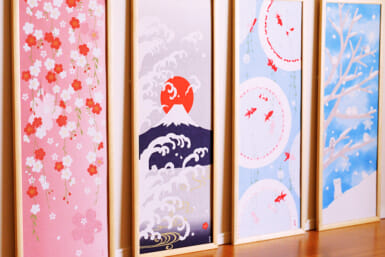by Jay and Sumi Gluck
authors of the guide books of the same name
THE BUDDHA PROGRAM
Buddhism is a religio-philosophical system whose followers hope to attain to a state of eternal bliss, the ultimate goal, the desire to end desires, to become a buddha, to become one with the past buddhas in buddha-hood, nirvana. The Buddhist who fails to do so in life finds his subsequent purgatory or hell in a rebirth, in a second or third or infinite number of chances.
Art is a medium of educating the observer towards this goal by providing him with focal points such as in the form of portraits of beings exemplifying the desired qualities, illustrations of certain tenets. It is then, by its very nature, enigmatic and, by this same nature, next to impossible to explain just what the statues in the temples portray. But a few key hints can help the casual observer to make rough identifications of the sculptures one sees.
In brief, there have been and will be infinite buddhas for this and all the infinite worlds. But there is one ultimate Buddha of which all buddhas, or beings, are manifestations. That Buddha is Dai-nichi, Great Light, the perfect gnosis.
The Great Buddha of Nara is a Dai-nichi, and on each of the petals of the lotus on which he sits is a picture of a Buddha of another world. Dai-nichi will usually be shown in kingly garments idealized, that is with very ornate filigree crown and jewels. Or he may be shown in the more traditional “Buddha” form without ornamentation, as in the Great Buddha, in which case his petal-shaped halo will be studded with innumerable subsidiary buddhas and he will be called by his alias, Roshana.
Earth exists through five kalpas, or great eons. Each has its own essential buddha who is motionless in demonstration of the total end of desire, end of action. Each era-buddha has his active manifestation called a bodhisattva, or bosatsu in Japanese, who is incarnated in flesh and blood. We are now in the fourth kalpa, the Buddhistic quaternary.
The Essential Buddha of our eon is Amida, he of the Great Buddha of Kamakura. His Bosatsu is Kannon, “Goddess of Mercy” in popular terminology His/her terrestrial incarnation is the man we know of by the popular name of The Buddha, whom the Japanese call Shaka-sama, and who was by name the Indian prince Siddhartha who in his later years was called Shakyamuni, the sage of the Shakya clan and who lived, as near as we can tell, 567-488 B.C.
Popularly, the Japanese have sloughed over the differentiations in rank between the three members of each trinity. Being in the fourth kalpa there have been 12, and then there is number 13, “The Coming Buddha,” the Maitreya or Miroku-Bosatsu. These 13 the Japanese call the 13 nyorai. Sometime they just lump the essential and terrestrial buddhas as nyorai, and count the bosatsu separately. How then can we? Telling the buddhas apart is a problem. The bosatsu are a little easier.
The bosatsu is easily differentiated as he/she has attained all earthly success and is ready to become a buddha. He wears all the status symbols of a king—crown, jewels, etc.—but wears them lightly as they don’t matter. But he does not become a buddha for he makes the supreme martyrdom of choosing to remain in this vale of misery to help ethers. With such infinite qualities, infinite mercy and infinite problems in our quarternary world to solve, there are understandably infinite representations possible for the Bosatsu of our era, kannon (after whom Canon camera is named).
You will hear the title bosatsu affixed to many images, and kannon to almost as many. He wears a horse head, a crown of 10 heads (which with his own makes him 11-headed kannon), with several arms, a thousand arms. But if it is kannon and not another bosatsu he will have a crown with a small Buddha in it, his spiritual father, Amida. But a bosatsu is always ornately bejeweled. Roadside stone jizo status are bosatsu, though lightly jewelled.
The nyorai, whether human or abstract, is shown as a simple human who having gone far beyond all human desire, is unadorned and simply draped. However, look for certain peculiarities: curly hair, a heritage of curly-moppeted Greek statues; the bump of knowledge, actually the top knot on which Prince Siddhartha wore his now-discarded crown: long ear lobes, elongated by the weight of the now-discarded earrings; the “third eye” in the forehead, actually his Indian caste mark. Dai-nichi nyorai we already discussed. Amida, basic to the national cults of Nichiren-shu and the modern militant Sokka Gakkai, is more often as not shown seated with his hands in the position of total rest, palms up, one atop the other in the lap.
Yakushi, nyorai, the Healing Buddha of Horyuji Temple, among other places, will usually be shown standing, left hand raised in a casual “hi-there” – which actually portrays in hand language “fear not, listen”—and often proferring a bottle of medicine in the other hand.
Miroku, the Maitreya, Messiah or coming buddha, is often as not shown a la Rodin’s thinker, squatting pensively, with or without jewels.
Shaka, the man who lived 2500 years ago, is probably what he is if he is unadorned and not evidently one of the above. Probably!!? Maybe??!
The hand signs, or mudra, which distinguish some of the figures are an entire language, each with a definite meaning, but some of such esoteric nature as to be considered “secret.” But the most common are:
—Hand down, palm to ground: suppress earthly evil
—Hand down finger tips touching earth: I give earthly proof
—Hand down, palm up: giving
—Palm up, thumb ringing with 2nd or 3rd finger: discussing
—Same but thumb and forefinger in OK ring: Amida welcomes to Nirvana
—Hand down, palm up, thumb-finger joined; enumerating reasons
—One finger raised and grasped in other fist: all is one, Dai-nichi
—Hands clasped, forefingers raised: moment of enlightenment
—Fist in lap, covered by other palm; invisibility
—Both palms raised and joined, but forefingers and thumbs in twin “OK” ring, means nothing is unattainable, not even trying to figure out what it is the statues are trying to tell us.
And then there are the zillions of demons and lesser things. But save that for an edition in the next kalpa.








